2006 KIA Sportage air condition
[x] Cancel search: air conditionPage 12 of 354
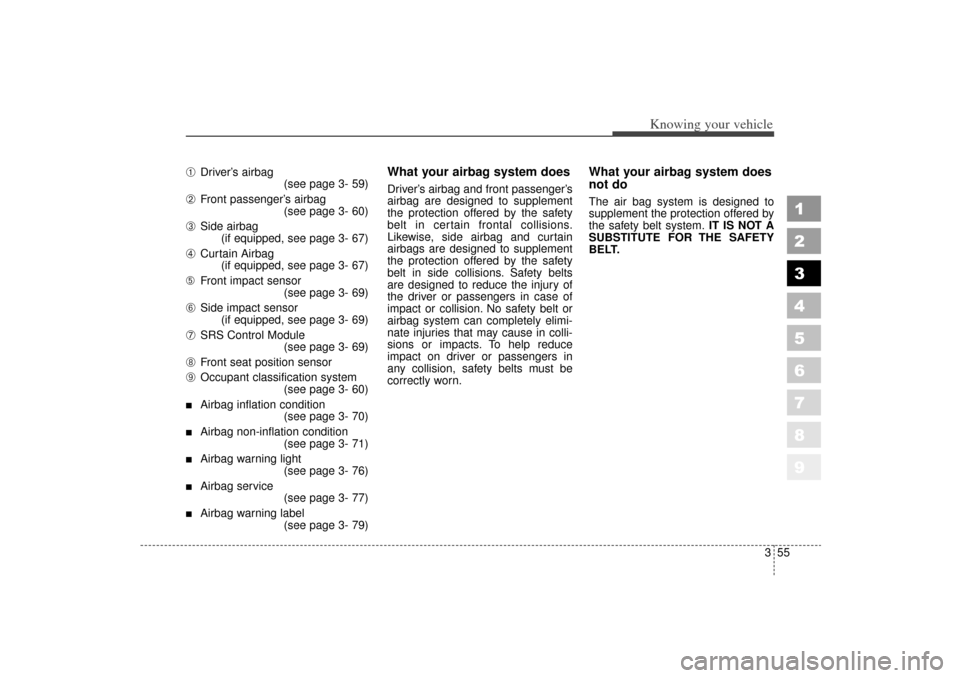
355
1
2
3
4
5
6
7
8
9
Knowing your vehicle
➀
Driver’s airbag(see page 3- 59)
➁
Front passenger’s airbag(see page 3- 60)
➂
Side airbag(if equipped, see page 3- 67)
➃
Curtain Airbag(if equipped, see page 3- 67)
➄ Front impact sensor
(see page 3- 69)
➅
Side impact sensor(if equipped, see page 3- 69)
➆
SRS Control Module (see page 3- 69)
\b
Front seat position sensor
➈
Occupant classification system(see page 3- 60)
Airbag inflation condition(see page 3- 70)
Airbag non-inflation condition(see page 3- 71)
Airbag warning light(see page 3- 76)
Airbag service(see page 3- 77)
Airbag warning label(see page 3- 79)
What your airbag system doesDriver’s airbag and front passenger’s
airbag are designed to supplement
the protection offered by the safety
belt in certain frontal collisions.
Likewise, side airbag and curtain
airbags are designed to supplement
the protection offered by the safety
belt in side collisions. Safety belts
are designed to reduce the injury of
the driver or passengers in case of
impact or collision. No safety belt or
airbag system can completely elimi-
nate injuries that may cause in colli-
sions or impacts. To help reduce
impact on driver or passengers in
any collision, safety belts must be
correctly worn.
What your airbag system does
not doThe air bag system is designed to
supplement the protection offered by
the safety belt system. IT IS NOT A
SUBSTITUTE FOR THE SAFETY
BELT.
KM CAN (ENG) 3 (55~)new.qxd 7/29/05 9:37 AM Page 55
Page 14 of 354

357
1
2
3
4
5
6
7
8
9
Knowing your vehicle
Airbag system components The main components of your SRS
are:
To indicate that your vehicle isequipped with airbags, the corre-
sponding airbag covers are
marked with “SRS AIRBAG”.
- Driver’s airbag (see page 3- 59)
- Passenger’s airbag (see page 3- 60)
- Side airbag (if equipped, see page 3- 67)
- Curtain airbag (if equipped, see page 3- 67)
A diagnostic system that continual- ly monitors the system operation.
Airbag warning light to warn you of a possible problem with the sys-
tem.
Emergency power backup in case your car’s electrical system is dis-
connected in a crash. The SRS uses a collection of sen-
sors to gather information about the
driver’s and front passenger’s seat
position, the driver’s and front pas-
senger’s safety belt usage and
impact severity.
The driver's and front passenger's
seat position sensors, which are
installed on the seat track let the
airbag control module know where
the seats are positioned. Similarly,
the safety belt usage sensors meas-
ure if the driver and front passenger’s
safety belts are fastened. These sen-
sors provide the ability to control the
SRS deployment based on how
close the driver’s seat is to the steer-
ing wheel, how close the passen-
ger’s seat is to the instrument panel,
whether or not the safety belts are
fastened, and the severity of the
impact.
(Continued)
If your vehicle has been sub-
jected to flood conditions (e.g.
soaked carpeting/standing
water on the floor of the vehi-
cle, etc.) or if your vehicle has
become flood damaged in any
way, do not attempt to start
the vehicle or put the key in
the ignition. Have the vehicle
towed to an authorized Kia
dealer for inspection and nec-
essary repairs.
Disregarding this precaution
may cause an unexpected
airbag deployment, which
could result in serious per-
sonal injury or death.
KM CAN (ENG) 3 (55~)new.qxd 7/29/05 9:37 AM Page 57
Page 15 of 354
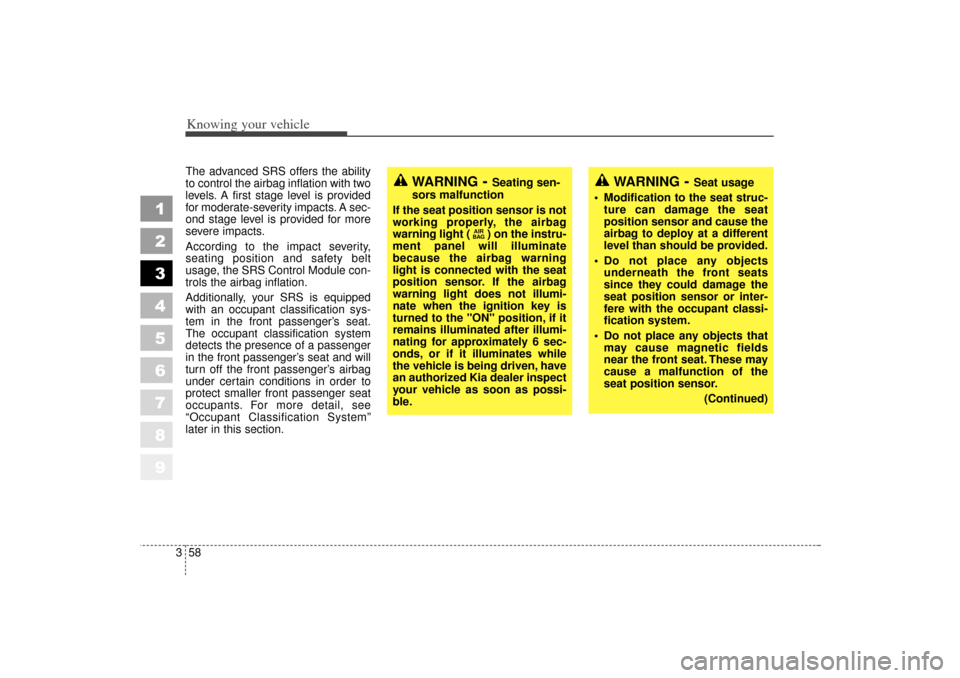
Knowing your vehicle58
3
1
2
3
4
5
6
7
8
9
The advanced SRS offers the ability
to control the airbag inflation with two
levels. A first stage level is provided
for moderate-severity impacts. A sec-
ond stage level is provided for more
severe impacts.
According to the impact severity,
seating position and safety belt
usage, the SRS Control Module con-
trols the airbag inflation.
Additionally, your SRS is equipped
with an occupant classification sys-
tem in the front passenger’s seat.
The occupant classification system
detects the presence of a passenger
in the front passenger’s seat and will
turn off the front passenger’s airbag
under certain conditions in order to
protect smaller front passenger seat
occupants. For more detail, see
“Occupant Classification System”
later in this section.
WARNING
- Seating sen-
sors malfunction
If the seat position sensor is not
working properly, the airbag
warning light ( ) on the instru-
ment panel will illuminate
because the airbag warning
light is connected with the seat
position sensor. If the airbag
warning light does not illumi-
nate when the ignition key is
turned to the "ON" position, if it
remains illuminated after illumi-
nating for approximately 6 sec-
onds, or if it illuminates while
the vehicle is being driven, have
an authorized Kia dealer inspect
your vehicle as soon as possi-
ble.
AIR
BAG
WARNING
- Seat usage
Modification to the seat struc- ture can damage the seat
position sensor and cause the
airbag to deploy at a different
level than should be provided.
Do not place any objects underneath the front seats
since they could damage the
seat position sensor or inter-
fere with the occupant classi-
fication system.
Do not place any objects that may cause magnetic fields
near the front seat. These may
cause a malfunction of the
seat position sensor.
(Continued)
KM CAN (ENG) 3 (55~)new.qxd 7/29/05 9:37 AM Page 58
Page 17 of 354
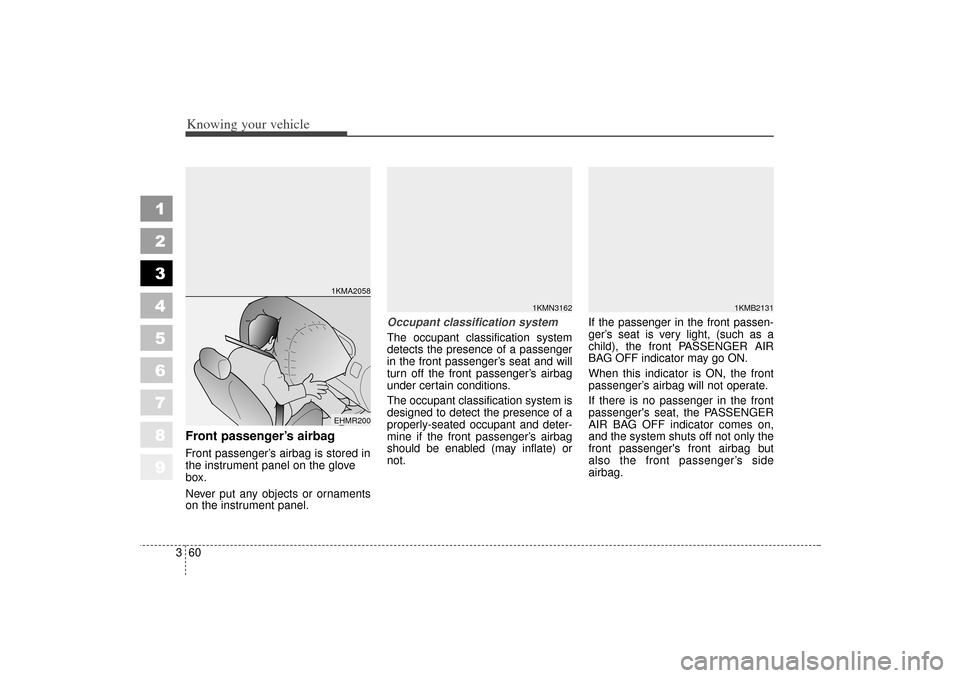
Knowing your vehicle60
3
1
2
3
4
5
6
7
8
9
Front passenger’s airbagFront passenger’s airbag is stored in
the instrument panel on the glove
box.
Never put any objects or ornaments
on the instrument panel. Occupant classification system
The occupant classification system
detects the presence of a passenger
in the front passenger’s seat and will
turn off the front passenger’s airbag
under certain conditions.
The occupant classification system is
designed to detect the presence of a
properly-seated occupant and deter-
mine if the front passenger’s airbag
should be enabled (may inflate) or
not.
If the passenger in the front passen-
ger’s seat is very light, (such as a
child), the front PASSENGER AIR
BAG OFF indicator may go ON.
When this indicator is ON, the front
passenger’s airbag will not operate.
If there is no passenger in the front
passenger's seat, the PASSENGER
AIR BAG OFF indicator comes on,
and the system shuts off not only the
front passenger's front airbag but
also the front passenger’s side
airbag.
1KMB2131
1KMN3162
1KMA2058EHMR200
KM CAN (ENG) 3 (55~)new.qxd 7/29/05 9:37 AM Page 60
Page 19 of 354
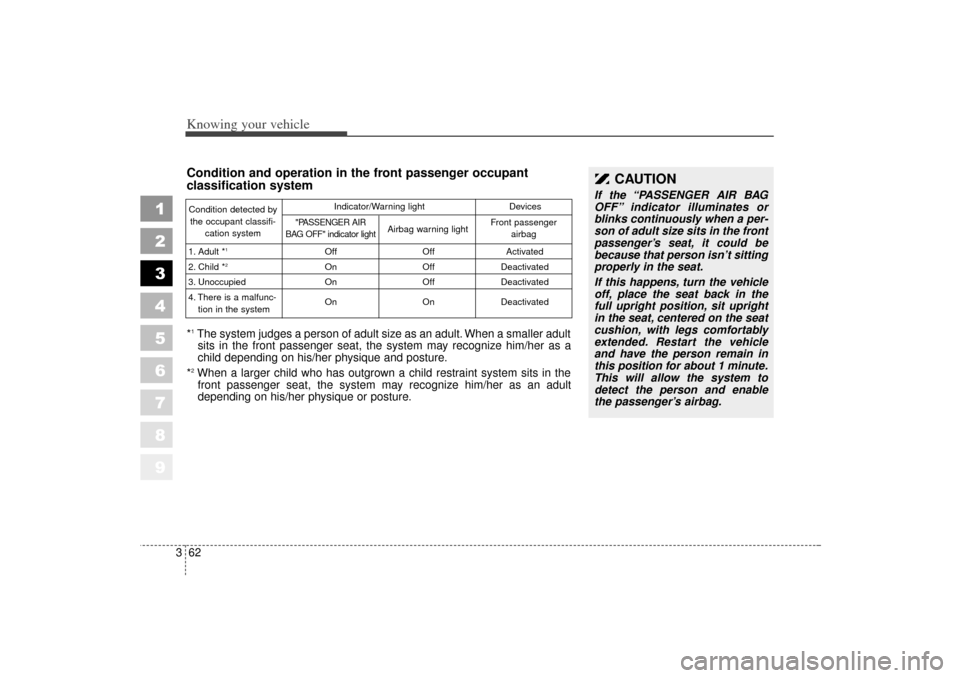
Knowing your vehicle62
3
1
2
3
4
5
6
7
8
9
CAUTION
If the “PASSENGER AIR BAG
OFF” indicator illuminates or
blinks continuously when a per-
son of adult size sits in the front
passenger’s seat, it could be
because that person isn’t sitting
properly in the seat.
If this happens, turn the vehicle
off, place the seat back in the
full upright position, sit upright
in the seat, centered on the seat
cushion, with legs comfortably
extended. Restart the vehicle
and have the person remain in
this position for about 1 minute.
This will allow the system to
detect the person and enable
the passenger’s airbag.
Condition and operation in the front passenger occupant
classification systemCondition detected by
the occupant classifi- cation system
1. Adult *
1
2. Child *
2
3. Unoccupied
4. There is a malfunc- tion in the system Off
On
On
On Off
Off
Off
On Activated
Deactivated
Deactivated
Deactivated
"PASSENGER AIR
BAG OFF" indicator light
Airbag warning light Front passenger
airbag
Indicator/Warning light Devices
*1The system judges a person of adult size as an adult. When a smaller adult
sits in the front passenger seat, the system may recognize him/her as a
child depending on his/her physique and posture.
*2When a larger child who has outgrown a child restraint system sits in the front passenger seat, the system may recognize him/her as an adult
depending on his/her physique or posture.
KM CAN (ENG) 3 (55~)new.qxd 7/29/05 9:37 AM Page 62
Page 22 of 354
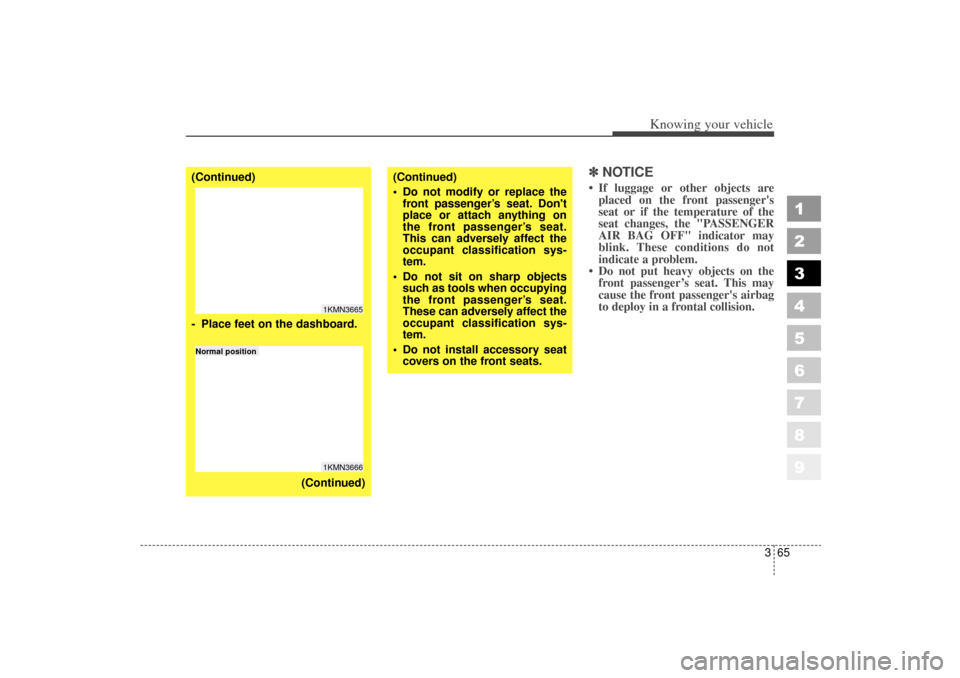
365
1
2
3
4
5
6
7
8
9
Knowing your vehicle
✽ ✽NOTICE• If luggage or other objects are
placed on the front passenger's
seat or if the temperature of the
seat changes, the "PASSENGER
AIR BAG OFF" indicator may
blink. These conditions do not
indicate a problem.
Do not put heavy objects on the front passenger’s seat. This may
cause the front passenger's airbag
to deploy in a frontal collision.
(Continued)
Do not modify or replace the
front passenger’s seat. Don't
place or attach anything on
the front passenger’s seat.
This can adversely affect the
occupant classification sys-
tem.
Do not sit on sharp objects such as tools when occupying
the front passenger’s seat.
These can adversely affect the
occupant classification sys-
tem.
Do not install accessory seat covers on the front seats.
(Continued)
- Place feet on the dashboard.
(Continued)
1KMN36651KMN3666
Normal position
KM CAN (ENG) 3 (55~)new.qxd 7/29/05 9:37 AM Page 65
Page 24 of 354
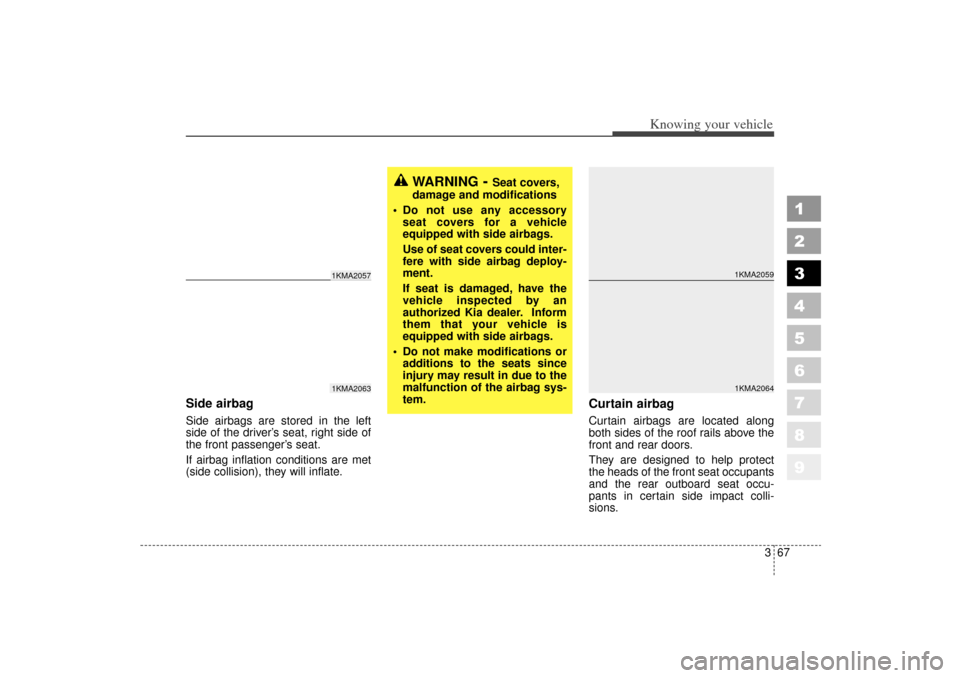
367
1
2
3
4
5
6
7
8
9
Knowing your vehicle
Side airbagSide airbags are stored in the left
side of the driver’s seat, right side of
the front passenger’s seat.
If airbag inflation conditions are met
(side collision), they will inflate.
Curtain airbagCurtain airbags are located along
both sides of the roof rails above the
front and rear doors.
They are designed to help protect
the heads of the front seat occupants
and the rear outboard seat occu-
pants in certain side impact colli-
sions.
WARNING
- Seat covers,
damage and modifications
Do not use any accessory seat covers for a vehicle
equipped with side airbags.
Use of seat covers could inter-
fere with side airbag deploy-
ment.
If seat is damaged, have the
vehicle inspected by an
authorized Kia dealer. Inform
them that your vehicle is
equipped with side airbags.
Do not make modifications or additions to the seats since
injury may result in due to the
malfunction of the airbag sys-
tem.
1KMA20631KMA2057
1KMA20591KMA2064
KM CAN (ENG) 3 (55~)new.qxd 7/29/05 9:37 AM Page 67
Page 27 of 354
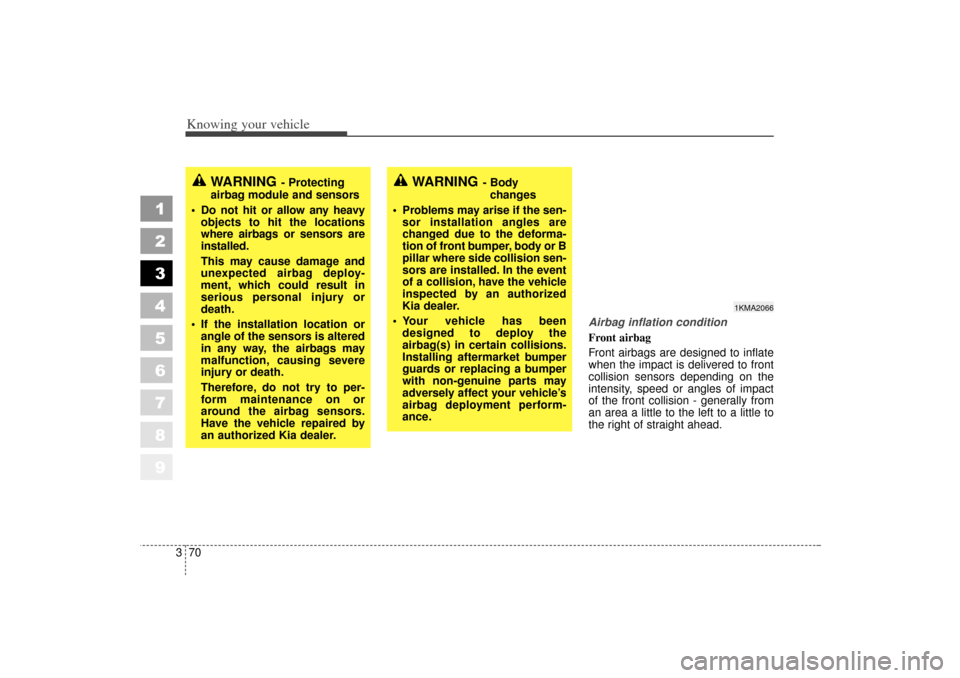
Knowing your vehicle70
3
1
2
3
4
5
6
7
8
9
Airbag inflation condition
Front airbag
Front airbags are designed to inflate
when the impact is delivered to front
collision sensors depending on the
intensity, speed or angles of impact
of the front collision - generally from
an area a little to the left to a little to
the right of straight ahead.
WARNING
- Protecting
airbag module and sensors
Do not hit or allow any heavy objects to hit the locations
where airbags or sensors are
installed.
This may cause damage and
unexpected airbag deploy-
ment, which could result in
serious personal injury or
death.
If the installation location or angle of the sensors is altered
in any way, the airbags may
malfunction, causing severe
injury or death.
Therefore, do not try to per-
form maintenance on or
around the airbag sensors.
Have the vehicle repaired by
an authorized Kia dealer.
WARNING
- Body
changes
Problems may arise if the sen- sor installation angles are
changed due to the deforma-
tion of front bumper, body or B
pillar where side collision sen-
sors are installed. In the event
of a collision, have the vehicle
inspected by an authorized
Kia dealer.
Your vehicle has been designed to deploy the
airbag(s) in certain collisions.
Installing aftermarket bumper
guards or replacing a bumper
with non-genuine parts may
adversely affect your vehicle’s
airbag deployment perform-
ance.
1KMA2066
KM CAN (ENG) 3 (55~)new.qxd 7/29/05 9:37 AM Page 70